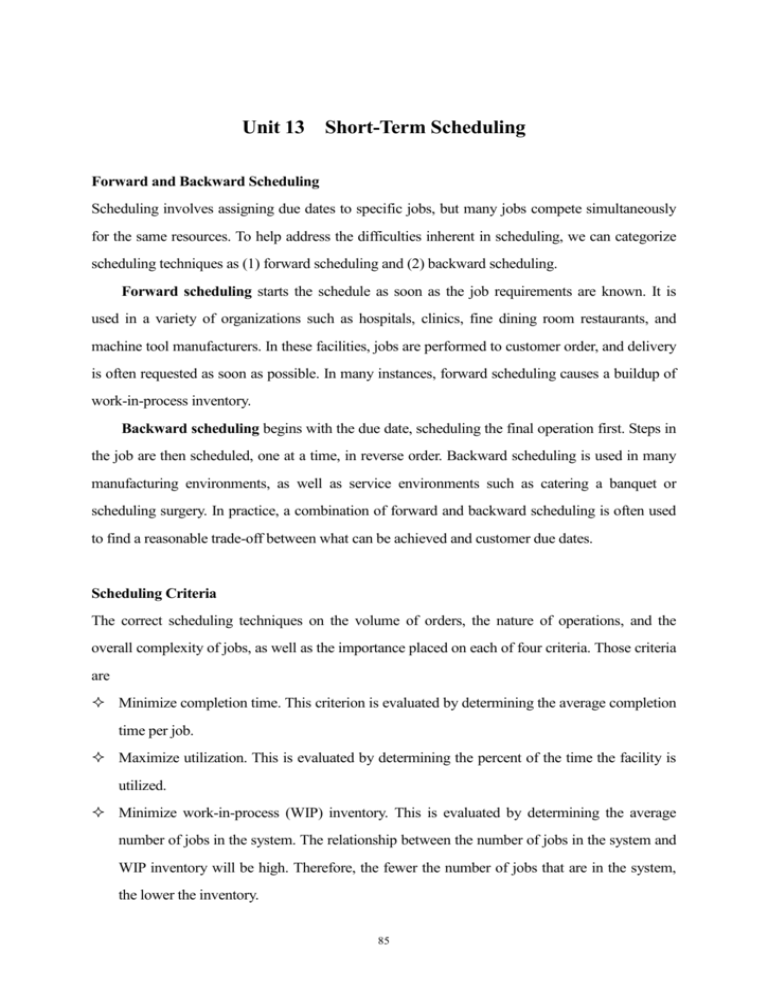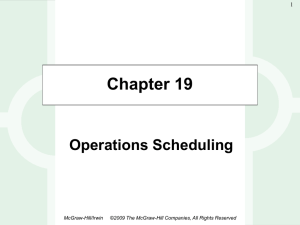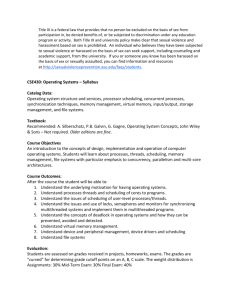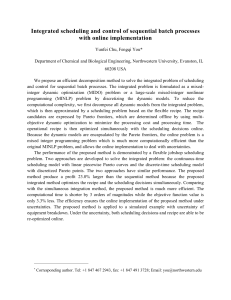13 Short-Term Scheduling p85-94
advertisement

Unit 13 Short-Term Scheduling Forward and Backward Scheduling Scheduling involves assigning due dates to specific jobs, but many jobs compete simultaneously for the same resources. To help address the difficulties inherent in scheduling, we can categorize scheduling techniques as (1) forward scheduling and (2) backward scheduling. Forward scheduling starts the schedule as soon as the job requirements are known. It is used in a variety of organizations such as hospitals, clinics, fine dining room restaurants, and machine tool manufacturers. In these facilities, jobs are performed to customer order, and delivery is often requested as soon as possible. In many instances, forward scheduling causes a buildup of work-in-process inventory. Backward scheduling begins with the due date, scheduling the final operation first. Steps in the job are then scheduled, one at a time, in reverse order. Backward scheduling is used in many manufacturing environments, as well as service environments such as catering a banquet or scheduling surgery. In practice, a combination of forward and backward scheduling is often used to find a reasonable trade-off between what can be achieved and customer due dates. Scheduling Criteria The correct scheduling techniques on the volume of orders, the nature of operations, and the overall complexity of jobs, as well as the importance placed on each of four criteria. Those criteria are Minimize completion time. This criterion is evaluated by determining the average completion time per job. Maximize utilization. This is evaluated by determining the percent of the time the facility is utilized. Minimize work-in-process (WIP) inventory. This is evaluated by determining the average number of jobs in the system. The relationship between the number of jobs in the system and WIP inventory will be high. Therefore, the fewer the number of jobs that are in the system, the lower the inventory. 85 Minimize customer waiting time. This is evaluated by determining the average number of late days. Input-Output Control Loading means the assignment of jobs to work or processing centers. Operations managers assign jobs to worker centers so that costs, idle time, or completion times are kept to a minimum. Many firms have difficulty scheduling because they overload the production processes. This often occurs because they do not know actual performance in the work centers. Effective scheduling depends on the matching the schedule to performance. Input-output control is a technique that allows operations personnel to manage facility work flows. If the work is arriving faster than it is being processed, we are overloading the facility and a backlog develops. Overloading causes crowding in the facility, leading to inefficiencies and quality problems. If the work is arriving at a slower rate than jobs are being performed, we are under-loading the facility and the work center may run out of work. Under-loading the facility results in idle capacity and wasted resources. The following example shows the use of input-output controls. Example 1 The following figure shows the planned capacity for the DNC milling work center for 5 weeks (weeks 6/6 through 7/4). Work Center DNC Milling (in thousand hours) Week Ending 6/6 6/13 6/20 6/27 Planned Input 280 280 280 280 Actual Input 270 250 280 285 Cumulative Deviation -10 -40 -40 -35 Planned output 320 320 320 320 Actual Output 270 270 270 270 Cumulative Deviation 0 -20 -10 +5 From the above figure, we can see that the performance is not very good. Some measures must be taken to improve the situation. You can choose to change capacity or input to achieve efficiency. 86 Gantt Chart Gantt chart are visual aids that are useful in loading and scheduling. The name is derived from Henry Gantt, who developed them in the late 1800s. The charts show the use of resources, such as work centers and labor. And it has many functions. For example, when one work center becomes overloaded, employees from a low-load center can be transferred temporarily to increase the workforce. Or if waiting jobs can be processed at different work centers, some jobs at high-load centers can be transferred to low-load centers. Versatile equipment may also be transferred among centers. Example 2 A New Orleans washing machine manufacturing accepts special orders for machines to be used in such unique facilities, hospitals, and large industrial laundries. The production of each machine requires varying tasks and durations. The following figure shows the load chart for the week of March 8. The four work centers process several jobs during the week. This particular chart indicates that the metalworks and planning centers are completely loaded for the entire week. The mechanical and electronic centers have some idle time scattering during the week. We also note that the metalworks center is unavailable on Tuesday and the painting center is unavailable on Tuesday. Day Monday Tuesday Wednesday Thursday Friday Work Centers Metalworks Job 349 Job 350 Mechanics Electronics Painting Job 349 Job 408 Job 408 Job 349 Job 295 Job 408 Job 349 Center not available (for example, maintenance time, repairs, shortages) Example 3 First Printing and Copy Center, in Winter Park, Florida, use the Gantt Chart in the following figure to show the scheduling of three orders, job A, B, and C. each pair of brackets on 87 the time axis denotes the estimated starting and finishing of a job enclosed within it. The solid bar reflects the actual status or progress of the job. Job A, for example, is about one-half day behind schedule at the end of day five. Job B is completed after equipment maintenance. Job C is ahead of schedule. Day Day Day Day Day Day Day Day 3 4 5 6 7 8 Job 1 2 A B C Time Range Progress Maintenance Time In the above figure, the striped line represents the reviewing date. Priority Rules for Dispatching Jobs Sequencing specifies the order in which jobs should be done at each center. For example, suppose that 10 patients are assigned to a medical clinic for treatment. In what order should they be treated? Sequencing methods provide such detailed information. Priority rules provide guidelines for the sequence in which jobs should be worked. The rules are especially applicable for process-focused facilities such as clinics, print shops, and manufacturing job shops. Priority rules try to minimize competition time, number of job in the system, and job lateness, while maximizing facility utilization. The most popular priority rules are FCFS: First come, first served. The first job to arrive at a work center is processed first. SPT: Shortest processing time. The shortest jobs are handled first and completed. EDD: Earliest due date. The job with the earliest due date is selected first. LPT: Longest processing time. The longer, bigger jobs are often very important and are selected first. Example 4 Some architectural rendering jobs are waiting to be assigned at smith, Tarney, and Barnes Architecture. Their work (processing) times and due dates are given in the following table. We want to determine the sequence of processing according to (1) FCFS, (2) SPT, (3) EDD, (4) 88 LPT rules. Jobs are assumed a letter in the order they arrived. Solution Job Times Job Due Date (days) (days) next table is simply A-B-C-D-E. The A 6 8 “Flow time” in the system for this B 2 6 sequence measures the time each job C 8 18 spends waiting plus time being D 3 15 processed. Job b, for example, waits E 9 23 6 days while job A is being processed, Job 1. The FCFS sequence shown in the then takes 2 more dates of operation time itself; so it will be completed in 8 days—which is 2 days later than its due date. Job Sequence Job Time Flow Time Job Due Date Job lateness A 6 6 8 0 B 2 8 6 2 C 8 16 18 0 D 3 19 15 4 E 9 28 23 5 28 77 11 Average time = 77days/5=15.4 days Utilization = 28/77=36.4% Average number of jobs in the system = 77/28 =2.75 jobs Average job lateness = 11/5 =2.2 days 2. The SPT rule shown in the next table results in the sequence B-D-A-C-E. Orders are sequenced according to processing time, with the highest priority to the shortest job. Average time = 65days/5=13 days Utilization = 28/65=43.1% Average number of jobs in the system = 65/28 =2.32 jobs Average job lateness = 9/5 =1.8 days 89 Job Sequence Job Time Flow Time Job Due Date Job lateness B 2 2 6 0 D 3 5 15 0 A 6 11 8 3 C 8 19 18 1 E 9 28 23 5 28 65 9 3. The EDD rule shown in the following table gives the sequence B-A-D-C-E. Note that jobs are ordered by earliest due date first. Job Sequence Job Time Flow Time Job Due Date Job lateness B 2 2 6 0 A 6 8 8 0 D 3 11 15 0 C 8 19 18 1 E 9 28 23 5 28 68 6 Average time = 68days/5=13.6 days Utilization = 28/68=41.2% Average number of jobs in the system = 68/28 =2.43 jobs Average job lateness = 6/5 =1.2 days 4. The LPT rule shown in the next table results in the order E-C-A-D-B. Job Sequence Job Time Flow Time Job Due Date Job lateness E 9 9 23 0 C 8 17 18 0 A 6 23 8 15 D 3 26 15 11 B 2 28 6 22 28 103 90 48 Average time = 103days/5=20.6 days Utilization = 28/103=27.2% Average number of jobs in the system = 103/28 =3.68 jobs Average job lateness = 48/5 =9.6 days As we can see in the above example, LPT is the least effective measurement of sequencing for the Smith, Tarney and Barnes firm. SPT is superior in three measures and EDD in the fourth (average lateness). This is typically true in the real world also. Experience indicates the following: 1. Shortest processing time is generally the best technique for minimizing job flow and minimizing the average number of jobs in the system. Its chief disadvantage is that long-duration jobs may be continuously pushed back in priority in favor of short-duration jobs. Customers may view this dimly, and periodic adjustment for longer jobs must be made. 2. First come, first served does not score well on most criteria (but neither does it score particularly poorly) it has the advantage, however, of appearing fair to customers, which is important in service system. Critical Ratio Another type of sequencing rule is the critical ratio. The Critical Ratio (CR) is an index number computed by dividing the time remaining until due date by the work time remaining. As proposed to priority rule, critical ratio is dynamic and easily updated. It tends to perform better than FCFS, SPT, EDD, or LPT on the average job-lateness criterion. The critical ratio gives priority to jobs that must be done to keep shipping on schedule. A job with a low critical ratio (less than 1.0) is the one that is falling behind schedule. If CR is exactly 1.0, the job is on schedule. A CR greater than 1.0 means the job is ahead of schedule and have some slack. The formula for critical ratio is Due date –Today’s date Time remaining CR = = Workdays remaining Work time remaining Example 5 Today is day 25 on Ayco Medical Laboratories’ production schedule. Three jobs are on order, as shown here: 91 Job Due Date Workdays Remaining A 30 4 B 28 5 C 27 2 We compute the critical ratio, using the formula for CR Job Due Date Workdays Remaining A (30–25)/4=1.25 3 B (28–25)/5=0.60 1 C (27–25)/2=1.00 2 Job B has a critical ratio of less than 1, meaning it will be late unless expedited. Thus, it has the highest priority. Job C is on time and job A has some slack. In most production scheduling systems, the critical–ratio rule can help to do the following: 1. Determine the status of a specific job. 2. Establish relative priority among jobs on a common basis. 3. Adjust priority automatically for changes in both demand and job progress. Sequencing N jobs on Two Machines: Johnson’s Rule The next step in complexity is the case in which n jobs (where N is 2 or more) must go through two different machines or work centers in the same order. This is called the N/2 problem. Johnson’s rule can be used to minimize the processing time for sequencing a group of jobs through two work centers. It also minimizes total idle time on the machines. It involves four steps: 1. All jobs are to be listed, and the time that each requires on a machine is to be shown. 2. Select the job with the shortest activity time. If the shortest time lies with the first machine, the job is scheduled first. If the shortest time lies with the second machine, schedule the job last. Ties in activity times can be broken arbitrarily. 3. Once a job is scheduled, eliminate it. 4. Apply steps 2 and 3 to the remaining jobs, working toward the center of the sequence. Example 7 Five specialty jobs at a Fredonia, New York and the jobs must be processed through 92 two worker centers (drill press and lathe). The time for processing each job follows: Work (processing) Time for Jobs (in hours) Job Work Center 1 (drill press) Work center 2 (lathe) A 5 2 B 3 6 C 8 4 D 10 7 E 7 12 1. We wish to set the sequence that will minimize the total processing time for the five jobs. The job with the shortest processing time is A, in work center 2. Therefore, put it at the end of the second work center. And eliminate it from consideration. 2. Job B has the next shortest time, and at the first work center. Accordingly, it is scheduled at the first. And eliminate it from consideration. 3. The next shortest time is job C (4 hours) on the second machine. Therefore, it is placed as late as possible. 4. There is a tie (at 7 hours) for the shortest remaining job. We can place E, which is on the first work center, first. Then D is placed the last sequencing position. The position and sequential time are as follows. Sequence B E D C A Work center 1 3 7 10 8 5 Work center 2 6 12 7 4 2 Limitation of Rule-Based Dispatching Systems The scheduling techniques just discussed are rule-based techniques. But rule-based systems have a number of limitations. Among those: 1. Scheduling is dynamic; therefore, rules need to be revised to adjust to changes in process, equipment, product mix, and so forth. 2. Idle resources and bottleneck resource in other departments may not be recognized. 3. Rules do not look beyond due dates. For instance, two orders may have the same due date. 93 One order, for example, involves restocking a distributor and the other is a customer order that will shut down the customer’s factory if not completed. Both may have the same due date, but clearly the customer order is more important. Despite these limitations, schedulers often use sequencing rules. They modify the sequence to deal with a multitude of real-world variable. They may do this manually or with finite scheduling software. Finite Scheduling A recent advance in short-term scheduling is interactive finite scheduling. This system is characterized by the ability of the scheduler to make changes based on up-to-minute information. These schedules are often displayed in Gantt chart form. The scheduler has the flexibility to handle any situation, including order, labor, or machine changes. Finite scheduling allows delivery needs to be balanced against efficiency based on today’s conditions and today’s orders, not according to some predefined rule. Many of the current finite scheduling computer programs offer resource constraint features, a multitude of rules, and the ability of the scheduler to work interactively with the scheduling system to create a realistic schedule. Interactive finite Scheduling Mater schedule Priority rules Expert system Gantt Chart (Computer System) Data for Inventory System Simulation models Reference Jay Heizer, Barry Render: Operations Management, Prentice Hall & 清华大学出版社, 2001 年。 94








